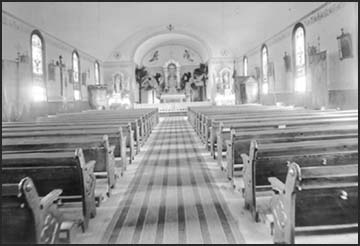St. Agnes celebrates centennial
This article submitted by Linda Stelling on 6/9/98.
The St. Agnes Catholic Church parish has been busy preparing for a big day on June 14, the day when they celebrate the churchís 100th anniversary.On Sunday, the parish will hold a mass at 10:05 a.m. with Bishop John F. Kinney of the St. Cloud Diocese present. Following mass, a catered dinner will be held in the church. From 12 to 2 p.m. , Betty Wolf and John Buermann will be providing musical entertainment. The childrenís choir will perform a song and dance routine from 2 to 3 p.m., under the direction of Joyce Olmscheid.
ďPlanning started two years ago for the celebration,Ē Father Leo Leisen said. The parish has been sprucing up the church with new carpeting and paneling in the basement.
As part of the celebration, Father Leisen compiled a history of the church ďA People and Their Journey.Ē
The journey of the parish began in March 1898 in F. W. Hilgerís dry goods store. A group gathered to discuss organizing a parish in Roscoe for the convenience of six Catholic families living in town and for the farmers in the surrounding countryside. Hilger, Joe Rothstein and Anton Schmitt each pledged $500 to a building fund, and Gregor Kost donated four acres of land.
The committee of Hilger, Lambert Knese and Herman Schaefers assured the bishop that Roscoeís aim was a resident pastor, a church, and a parsonage not just holding mass once or twice a month. They started with about 50 families and added six additional families in 1899.
 Parish members helped with the church construction. Parishioners worked eagerly and dug the 40 by 100-foot basement, hauled foundation stones and gave whatever help they could to the project. The foundation was ready July 18, 1898 when the crew of carpenters arrived from St. Cloud to erect the structure. By mid-October both the church and rectory were completed at a cost of $6,500.
Parish members helped with the church construction. Parishioners worked eagerly and dug the 40 by 100-foot basement, hauled foundation stones and gave whatever help they could to the project. The foundation was ready July 18, 1898 when the crew of carpenters arrived from St. Cloud to erect the structure. By mid-October both the church and rectory were completed at a cost of $6,500.
Due to the shortage of priests, the Benedictine Fathers were given charge of the parish. Father Martin Schmitt, OSB, was appointed to the new parish.
A three-day celebration marked the dedication of St. Agnes Catholic Church on Oct. 18, 1898. Money raised ($594) paid for the altar, 60 pews, and other furniture for the church (photo is of inside of this first church) and rectory.
The church was named St. Agnes in honor of the bishop who was the founding pastor of St. Agnes Parish in St. Paul.
In 1915, Father Ferstl OSB directed the installation of the new main and side altars as well as new stained glass windows. A cemetery fence was erected the same year. In 1925 the main altar was remodeled and in 1926, new stations of the cross were installed.
Tragedy struck the parish on Sept. 8, 1928. Shortly after first Friday devotions, a fire destroyed the church and rectory. During the aftermath, church services were held in a downtown building currently housing the Roscoe Bar. With his home destroyed, Father Scherer boarded with the Martin Ley family.
According to St. Agnesí 1948 Golden Jubilee book, ďThe church bell was stolen from the debris (from the fire) before it could have cooled from the intense heat to which it had been subjected.Ē There was no report of any thief being caught red-handed.
The devastation was minimal on the spirits of the pastor and parishioners. They lost no time in erecting a new church and rectory at a cost of $48,000. The new building was constructed of brick and was considered virtually fireproof. This structure still stands today.
When St. Agnes Parish was established, there were certain boundaries set, which meant that Catholic people in the area would automatically belong to that parish. St. Agnes boundaries covered five square miles. Father Andrew Nolen described St. Agnes as the ďfamilies around the Roscoe Prairie, Zion Hillside from Big Weis Lake, Rice Island and Pirz Pond.Ē
At present, parish members are pretty well scattered over the area. At one time, there were no Catholics west of Roscoe; most of the parishioners came from Roscoe or lived in the country towards Rice Lake.
Like many of the neighboring parishes in 1898, sermons were in German, so were their prayer books. The question was asked in the 1919 report of the chancery office, ďHow many people of the parish cannot speak English?Ē The response was about a third.
There was a bowling alley set up outside the church, probably put up for some parish picnic and never taken down. ďThe story goes that Father Leo Winter, 1907-1910, would sometimes announce to his parishioners, ďThere will be no vespers this afternoon...there will be bowling,Ē Father Godfrey Diekmann, a friend of Father Winter, said.
Return to Archives
 Parish members helped with the church construction. Parishioners worked eagerly and dug the 40 by 100-foot basement, hauled foundation stones and gave whatever help they could to the project. The foundation was ready July 18, 1898 when the crew of carpenters arrived from St. Cloud to erect the structure. By mid-October both the church and rectory were completed at a cost of $6,500.
Parish members helped with the church construction. Parishioners worked eagerly and dug the 40 by 100-foot basement, hauled foundation stones and gave whatever help they could to the project. The foundation was ready July 18, 1898 when the crew of carpenters arrived from St. Cloud to erect the structure. By mid-October both the church and rectory were completed at a cost of $6,500.